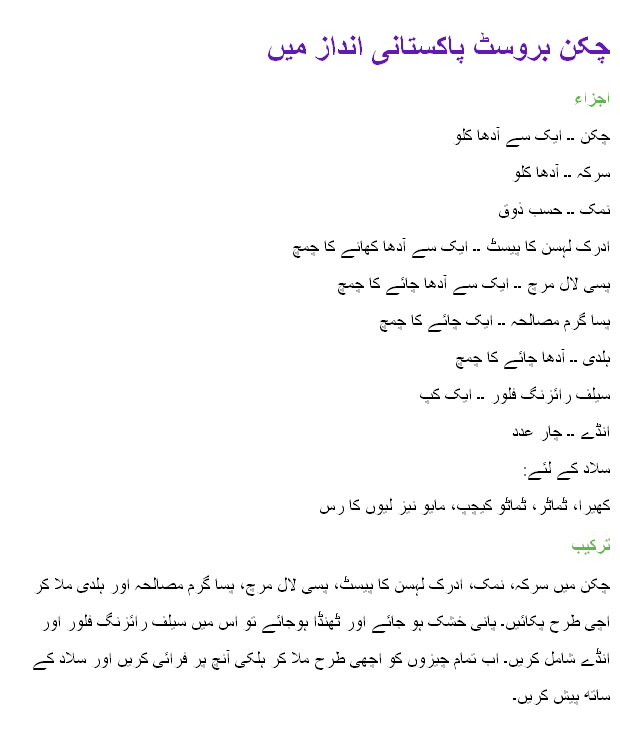Cooking Recipes

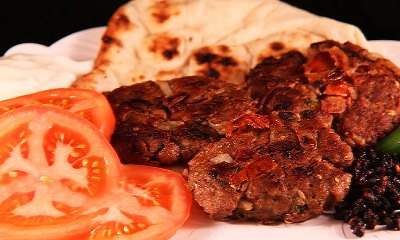
My cousin was a cadet at the Kimari Naval Base, and most of his weekends were spent at our home. The best part of his visit was the drop off to the Kimari Naval Base in the night, for on the way back my parents invariably made a stop at the dhaaba, where the garam naan andchapli kabab became a staple Saturday night dinner.
Come every Saturday morning, when I heard Azim bhai ring the doorbell my anticipation for the dinner that night would start. I could taste the flavour of the anardana and tomatoes wrapped in hot naan, the thin layer of fat on the roof of my month, and thus my belief that there is no better kabab than the authentic Peshawari chapli kabab; and here is its story.
The kabab, like most of the Food Stories covered, also has an ancient history. It has traveled far and wide through regions, times and people and has a universal appeal. Undoubtedly the most recognised eastern food in the western part of the world, it has remained a favourite with desis, middle easterners, Arabs, central Asians and Caucasians alike.
It is believed that the Turkish and Persian soldiers enjoyed grilling fresh meat on fire, while it hung wrapped on their swords. The meat chunks were cooked in animal fat and once ready were consumed immediately by soldiers who hunted for survival while journeying land to land for conquests.
Kababs have always been a rustic favourite; and while they were said to be a prominent part of the Moghul menu, the variation of the modern day chapli kabab is a purelyPakhtun take on the kabab.
The word kabab is said to originate from the Arabic language, but the Persians, Turks and central Asians also lay claim to it. It means to fry, burn or cook on a skewer through grilling or open fire cooking. Kababs in the west are mostly served on a skewer ordonar kabab with a side of pilaf or middle Eastern pita bread. Though in the subcontinent, there are more than a dozen popular kabab recipes; shami, boti, seekh, bihari, galavati all come a close second to the Peshawari chapli kabab.
The province formerly known as NWFP and the eastern region of Afghanistan can proudly lay claim to the spicy flat meat beef patty, however, it stands as a favourite throughout Pakistan and India. Though some kababs are made using sheep, lamb, chicken or goat meat, the chapli kabab is a purely beef, and at times lamb fare.Chaprikh is a Pashto word meaning flat, and chapli is a derivation of this particular word; hence a flat round kabab. The Pakhtun recipe uses a perfect combination of beef and atta (wheat flour), thus this kabab in particular is lighter in taste.
The ingredients used in the preparation of chapli kababs are indigenous to Afghanistan therefore the use of pomegranate seeds and dry coriander seeds, which make thechapli kabab so unique in taste. The outcome is perfect on the palate and thus the region and the original chapli kabab makers deserve the highest grade on sharing this delicious local classic with the rest of the world.
Chapli Kabab
Ingredients (makes 11 to 13 kababs)
1 lbs ground beef
4 tbsp whole wheat flour
1 medium onion, chopped
1 tsp chillie powder
1 tsp cumin
1 tsp garam masala powder
salt to taste
4 tbsp fresh cilantro
2 green chillies, chopped
1 tbsp coriander seeds crushed
½ egg
1 tsp anardana [pomegranate seeds]
1 tbsp oil
½ tsp baking powder
2 medium tomatoes, chopped
Oil for frying
Method
Mix ingredient in a large bowl, make flat patty, and shallow fry to enjoy with naan anddahi.
-Photos by Fawad Ahmed
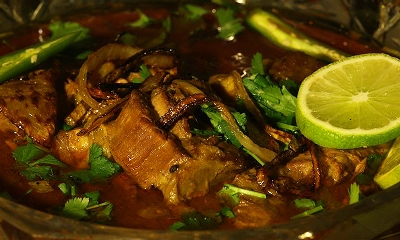
If you are a true Karachiite, you’ll know about a Botal gali. I was a frequent visitor of the street, for as a child I suffered from a nursemaid’s elbow and any tug or play of my arm would result in the dislocation of the radius (elbow joint). Each time I got the rag doll arm Abbo took me to Botal gali to the humble home of the gentle pehlwan (wrestler), a pro at gently nudging my elbow back in position. The pehlwan massaged a red pasty balm onto my arm, wrapped it in big green leaves and further covered it in muslin bandage. It was the 70s; Karachi was laid back and fabulous, the weekends were on Thursdays and there I was at Botal gali, a happy little wounded warrior. Being in the area, Abbo would often head on over afterwards to Sabri Nihari near Aram Bagh. And that is where I was first introduced to the majestic Nihari.
Nihari has a flavourful depth so deliberate that one can almost taste the unhurried and intentional consideration gone into putting the ingredients together. Therefore, the claim that Nihari is a derivation from the study of Hikmat(Eastern herbal medicine) comes as no surprise, not only was its consumption preventive against sinus, the common cold and the onset of fever in the winters of Delhi and Lucknow, it also gained popularity as a food that kept one warm during dropping temperatures.
The extravagant Nihari was initially served as breakfast to the rich Muslim Nawabs of pre-partition India, but the high classes soon realised that this rich thick curry, laden with tender chunks of veal and beef, slow cooked to perfection in the bone stock of shank meat had to be worked off once eaten, and who better to work it off but the labourers who were busy building India; onehaweli, mahal, sadrak and railway station at a time.
The word Nihari comes from the Arabic word Nahar which morning, thus the very name Nihari implies it is to be consumed early in the morning. Nihari is rumoured to have taken birth either in the back alleys of the Jamia Masjid in Delhi, where the Dehliwallas hail from, or as most Lucknawi loyalist believe in the kitchens of the Nawabs of Awadh, in the latter part of the 18th century at the decline of the Mughal Empire.
Legend suggests that the Empire and the ‘powers that be’ realised that this rich slow-cooked beef delicacy was the reason the Nawabs of Lucknow would take an indulgent nap between Fajr (morning) and Zohr (early afternoon) prayers. They ate Nihari for breakfast, especially in the winters and just slept it off. And, since the rich have been known to come up with innovative ways to work the poor, they decided to feed this delicacy to the labour class at construction sites as regular breakfast in lieu of ujrat (earned daily wages), the otherwise precious earnings after a hard days work. The high protein meat allowed for a progressively slow increase in blood sugar and therefore resulted in decreased cravings through the day. This practice continues to date; the labourer still eats Nihari early in the morning to sustain him through the day, and the wealthy for a weekend breakfast or as an indulgent dinner.
Historically, Nihari was cooked through the night for six to eight hours, and was ready to be served at sunrise. It was most delectable when cooked with veal or beef shank, though now mutton and chicken Nihari is popular too. Another variation in Nihari is the extra kick of magaz (brain) and nail (marrow) this is a special edition of Nihari. Real foodies consider it sacrilege to have Nihari sans the spare parts.
The method to cook Nihari has survived and remains somewhat similar to the early days. At the time, the lid of the daigh (large rounded pot) was sealed shut with lai (flour glue) to maintain maximum heat and steam for slow cooking. The meat was braised and then left to simmer in the aromatic and delightfully spicy essence of masalas. Gently, the meat soaked the flavour of the masalas as the masalas infused the heartiness of the meat; it was almost like one seducing the other ... to create magic.
A story that caught my fancy is one that my husband tells frequently. He visited Delhi in the 80s and made a trip to the old city of Delhi behind Jamia Masjid where the Nihariwallas cook, sell and tell Nihari stories with a passion. My husband’s cousin, who hails from Delhi took him to the oldest Nihariwalla in the city, on cue a behra arrived and while serving the Nihari special chatted away, claiming that they were all about to taste history! He explained that it was tradition that every day a small bowl of Nihari was saved to be poured into a fresh daigh of Nihari the next morning. He claimed, as did the head cashier, that the tradition had continued for time immemorial. I do not know the name of the restaurant or the authenticity of the story but to food romantics; the narrative carries tremendous historical splendour.
It was only natural then that I would undertake this herculean challenge. At first, I turned to my momani (maternal aunt) for her Nihari recipe only to discover that what we had been praising was actually prepackaged masala Nihari. The next stop was my lovely neighbourhood friend who makes fabulous homemade Nihari but brews it for two and a half days, that was too time consuming! So the intervention felt pretty divine when I stumbled upon Shazli Aunty’s Nihari recipe in a handwritten recipe book she had presented to me as my wedding present. Here it is, from my kitchen to yours.
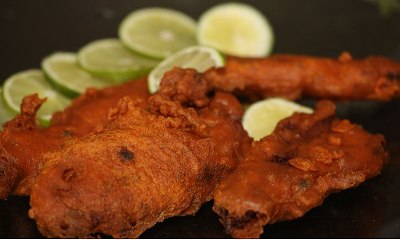
Sometimes a season, a picture, a memory can bring the taste of a particular food with it. One can almost taste it, smell it, savour it and the understanding that the only thing standing between me and the food is a delightful realisation, that now all I have to do is pick up the ingredients, put on an apron and get cooking; and voila, Lahori Fish is ready to be served.
Lahori Fish, this one sent me to the kitchen fast and to the grocery store faster. Once the fish, my favourite white meat, was set to marinade it gave me some time to research the history behind this delicious dish.
What’s the story of the fried fish? Is it its tender yet crisp texture that keeps us coming back for more? Or perhaps the simple fact that once caught, or bought, it takes a dash of butter, red pepper, salt, garlic, ginger and ten minutes on the skillet or karahi and you have dinner that’s a winner!
It is famously said in Don Quixote Hunger is the best sauce in the world and since peasants have a lot of it they always eat with zeal and zest. Yes, fish was a food of the coastal poor, and the ones living by rivers and lakes. And then ironically fresh fish jumped ship and became rich man’s food.
The bawarchees from the house of Mughals, under the influence of the cooks of Awadh, modern day Lucknow, decided to marinade the treasures of the sea and cooked and presented it to royal perfection, to the utter delight of the nawabs who joined Akbar for zohrana (lunch) and aashaiya (dinner) often.
But what about the simple city folk, the people of Lahore and of course Amritsar, sitting some thirty miles from Lahore, where fish was a frequent dinner delight in autumn, winter and spring?
In order to claim fish as their own dish they took to the hawandasta (mortar) powdered a few indigenous spices and set it to marinade in the cold winters of Lahore. The fish was then dipped in rice flour and besan (gram flour), and finally double fried it to orange perfection. What is the purpose of double frying it? In order to get the extra crispiness and crunch that enhances the taste significantly.
In the sub continent, particularly Punjab Rahu the sweet river fish is the most popular choice for the Lahori Fish. It is believed that the abundance of this river fish, from Darya-e-Ravi, and the blessing of cool glorious weather of the region from autumn to spring and of course basant, the festive celebration to welcome spring, inspired the Punjabi cooks to create the Lahori Fish.
History tells us that spring was the time when the locals enjoyed eating fried pakoras,kachorian, purian, all kinds of pakwans (batter fried or fried foods), and thus they decided to batter fry Rahu, and gave the batter an orange yellow hue, the colour that represents basant. This double battered fried fish became very popular in Punjab on both sides of the border.
Presented as street food, affordable, quick and scrumptious, however as its popularity grew it poised as a lavish dinner dish served with pride at celebrations across Pakistan.
In Indian Punjab this delectable fish, or a very similar tasting fish to the Lahori Fish, is very popular and goes by the name of Amritsari Fish. It is a fish from River Biyaas, double fried in a besan batter to orange golden perfection and served with green chutney.
It is a popular street favourite, therefore to presume that the people on both sides of the Wagah Border love this delicious batter delight is a safe assumption. It is served withhari chutney or imli (tamarind) chutney, or both if one wants an extra zing.
Winters in my neck of the woods are very 'Lahoreisque', dry, cold and glorious, so when my taste buds demanded a taste of Punjab I succumbed with pleasure. A quick call to my khala (maternal aunt) in Faisalabad and I had an authentic recipe. To my delight my friend Sandeep from Indian Punjab volunteered as the taste-tester representing Amritsari Fish, while I did the honour of taste testing my very own Lahori Fish. We both left the table happy campers. Here’s from my kitchen to yours.
Ingredients (serves 4 to 6)
1lbs fish fillets (6 to 8 pieces)
Spices for Marinade
1tsp red chilli powder
½ tsp crushed red pepper
1 tsp crushed cumin
½ tsp garam masala
1 tsp crushed dhanya seeds
½ tsp ajwain
1tsp crushed anaardaana
2 to 3 tbsp lemon juice
1 tsp crushed garlic
1 tsp crushed ginger
Salt to taste
1 tsp chopped green chilli
Ingredients for batter
1 cup besan
3 tbsp rice flour
½ tsp haldi
½ tsp red chilli powder
½ tsp baking powder
1tsp crushed garlic
1 egg
3 tbsp oil
1 ½ to 2 ½ mugs ice cold water, keeping the consistency like that of pakora batter
2 tsp orange colour
Salt to taste
Method
Wash fish and let dry, mix marinade and rub on fish, and let it rest six to eight hours in the fridge. Mix the batter by adding cold water and dip the fish fillets in the mixture. Heat oil and fry fillets for eight to 10 minutes, remove from fryer and leave it on oil absorbent paper towels until fillets are at room temperature. Reheat oil and refry fish fillets on high heat for two to four minutes. Remove from fryer and serve hot with hari or imli chutney,Lahori or Amritsari style.
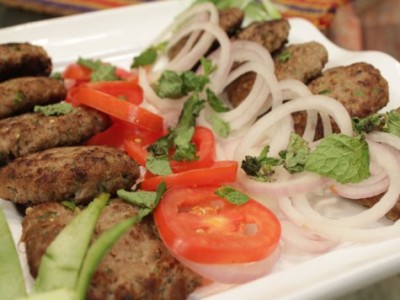
Tawa Kabab Recipe in Urdu is really healthy recipe as traditional cooking recipes. It is very easy to prepare and gives you unique taste of Beef & Mutton.

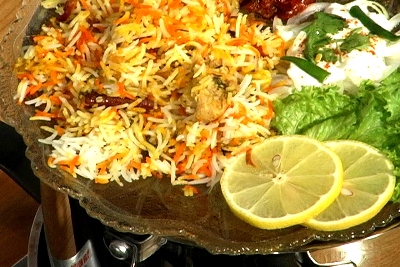
Sindhi Biryani Recipe in Urdu is really healthy recipe as traditional cooking recipes. It is very easy to prepare and gives you unique taste of Rice, Biryani, & Pulao

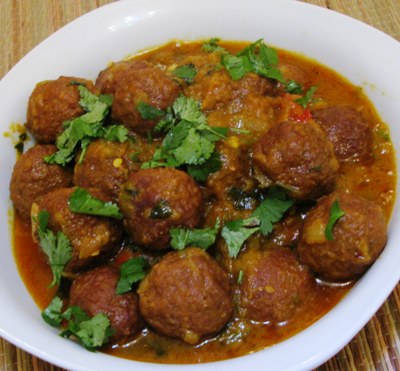
Kofta Curry is really healthy traditional cooking recipe. It is very easy to prepare and gives you unique taste of Pakistani Recipes
INGREDIENTS:
Mutton: boneless 1 KG
Onions: 2 pieces
Besan (roasted): 2 and half table spoons.
Egg: 1 piece
Ginger, Finely cut 2″inch piece
Green chilies: Finely cut 6 pieces.
Red chili powder: 1 table spoon.
Salt: as per Taste.
Oil: for frying.
For Curry
Onions: 3 pieces
Garlic: 3-5 Cloves
Ginger 1 1/2″ inch piece
Haldi powder 1 tea spoon
Tomatoes: boiled & skinned 1 cup.
Coriander leaves: 2 tea spoons
Red chili powder: 1 tea spoon
Garam masala: 1 tea spoon
Salt: as per Taste
METHOD :
For the koftas, mince the meat with all the other ingredients.
Remove the mixture and shape into balls.
Deep fry these balls till golden brown and keep aside.
For the curry, fry the onions, garlic and ginger till golden brown.
Add the rest of the curry ingredients with enough water to make a gravy.
Bring to a boil, add the fried koftas and simmer for 45 mins.
Garnish with chopped coriander leaves before serving.
Serve with Roti or Nan
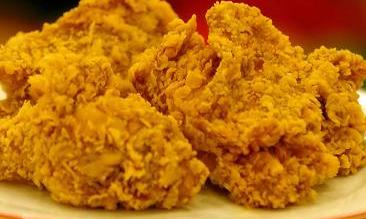
Chicken Broast Pakistani Style Recipe in Urdu is really healthy recipe as traditional cooking recipes. It is very easy to prepare and gives you unique taste of Special Pakistani Dishes.
